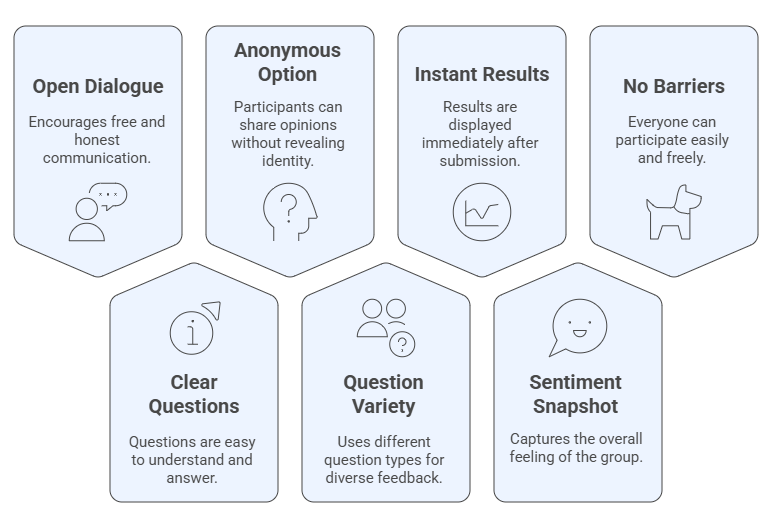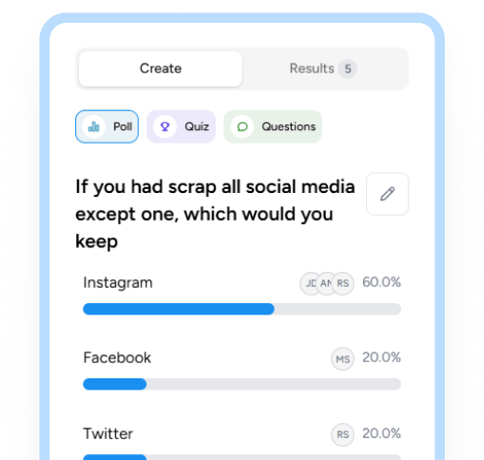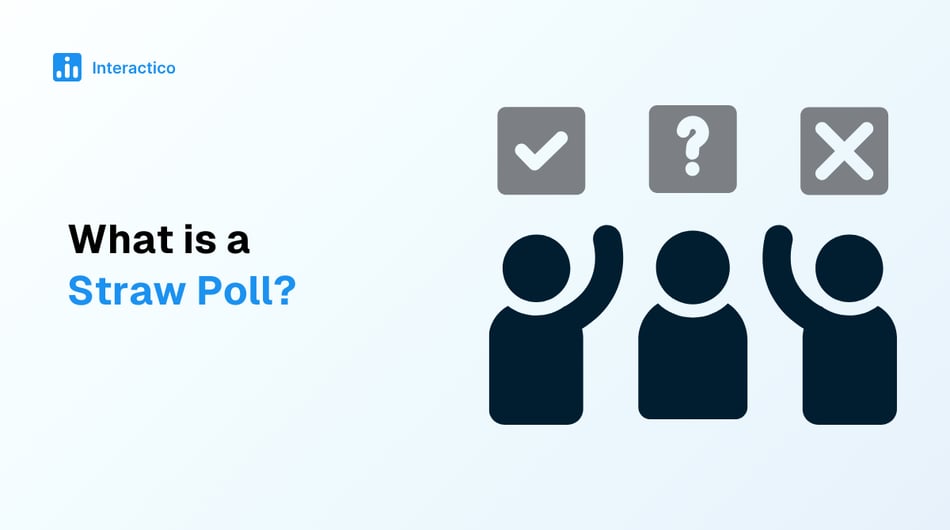Key Takeaways: Straw Polls
- A straw poll is an informal, non-binding vote designed to capture quick opinions.
- They are commonly used in politics, workplaces, education, and communities to gauge sentiment before formal decisions are made.
- Key features include simple questions, anonymity options, instant results, and low barriers to participation.
- Following best practices, such as keeping it short, humorous, and visually appealing, ensures that straw polls remain engaging and reliable for teams, communities, and political groups.
- While easy to use, they have limitations like a lack of scientific rigor and potential manipulation.
- Tools like Interactico make it easy to create straw polls, boosting participation and helping teams or groups make faster decisions.
If you’ve ever been asked to vote quickly on an idea, proposal, or policy without much background detail, you’ve likely taken part in a straw poll. While often informal, straw polls are a simple way to measure public opinion, team sentiment, or community preferences.
In workplaces and political discussions alike, these polls provide a quick “pulse check” before deeper decisions are made. Let’s break down the concept of straw polls with clear definitions, examples, and practical tips.
What is a Straw Poll & What is its Primary Goal?
An informal, non-binding vote conducted to determine opinions on a particular subject is called a straw poll. It is also known as a straw ballot or straw vote. In contrast to official surveys or elections, the purpose of a straw poll is to gather real-time responses and insights rather than to provide statistically representative findings.
A straw vote makes no claims to be accurate, in contrast to scientific surveys. Rather, it quickly and easily highlights trends and the overall atmosphere.
A straw poll’s primary goal is to:
- Give an overview of public opinion.
- Promote participation and conversation among group members.
- Assist organizers or leaders in experimenting before making a decision.
What are Some of the Most Prevalent Straw Poll Examples?
Straw votes are widely used in politics, workplaces, education, marketing, and even local communities to quickly gauge people’s opinions and inclinations. Below are some examples that show how they work in different settings.
-
Straw Poll Example 1: Workplace Culture
Question:
Do you feel your team communicates effectively during remote work?
- Yes
- No
- Sometimes
This poll helps managers quickly gauge employee sentiment on collaboration. While it doesn’t explain specific challenges, it highlights whether communication is seen as strong or needs improvement.
-
Straw Poll Example 2: Education
Question:
Should schools introduce later start times for high school students?
- Yes
- No
- Not sure
A simple way to capture opinions from parents, students, and teachers on a debated topic. It provides instant insight into community attitudes toward potential schedule changes.
-
Straw Poll Example 3: Product Feedback
Question:
Would you try a new flavor of your favorite coffee brand if it launched next month?
- Yes
- No
- Maybe
This poll gives brands a quick sense of customer interest before investing in a new product. It doesn’t reveal detailed preferences but shows whether there’s enough excitement to move forward.
What are the Key Characteristics That Make Straw Polls Popular
Straw polls are widely used because they are quick, practical, and easy to conduct. Below are the core characteristics that set them apart:

-
Open Dialogue
Straw ballots act as conversation starters by giving participants an easy way to voice their opinions. This often leads to deeper discussions and helps teams or groups identify common ground.
-
Clear and Straightforward Questions
The questions in straw polls are usually short and simple, which makes it easy for participants to respond without confusion. This clarity ensures higher response rates and more reliable insights.
-
Option for Anonymous Participation
Many straw vote tools allow users to vote anonymously, which reduces hesitation and encourages honest feedback. Anonymity makes participants feel more comfortable sharing their real opinions.
-
Variety of Question Formats
Straw polls can go beyond yes-or-no questions and include options like multiple choice or ranking. This flexibility makes them suitable for different contexts, from quick team check-ins to event planning.
-
Instant Visibility of Results
Responses are tallied in real time, so organizers and participants can immediately see where opinions stand. This instant feedback is valuable for fast decision-making.
-
Snapshot of Group Sentiment
Although not statistically rigorous, straw ballots often capture the current mood or preference of a group. They provide a useful snapshot that can guide next steps or spark more formal surveys.
-
No Barriers to Participation
Most polls don’t require sign-ups or logins, making them effortless to join. This low entry barrier encourages higher participation and keeps the process smooth.
Limitations of Straw Polls
While straw polls are convenient, they do come with a few drawbacks that you should keep in mind:
-
Minimal Customization Options
Most straw ballot platforms only offer basic templates. This makes it hard to adjust layouts, add branding, or include detailed question logic, limiting flexibility for more complex needs.
-
Not Scientifically Reliable
Straw votes are informal by nature. The sample size is often too small or biased. This means the results don’t accurately represent a larger population. They are better for quick insights than concrete decisions.
-
Susceptible to Bias or Manipulation
Because anyone with access to the link can vote, individuals might respond multiple times or share it within selective groups, skewing the outcome.
-
Lacks In-Depth Features
Unlike full survey platforms, straw ballots don’t provide analytics, data exports, or segmentation tools. This makes it difficult to study trends or dive deeper into participant behavior.
-
Potential for Misreading Results
Since results are instant and easy to view, organizers may treat them as conclusive. Without context, this snapshot can be misleading, especially when making important decisions.
Methodologies for Conducting Straw Polls
Depending on the situation, there are various approaches to conducting straw polls, including formal, casual, or traditional. Some of them are as follows:
-
Unofficial Samples
This entails soliciting the opinions of a small group of people without trying to be accurate.
-
A Variety of Formats
Straw polls can be conducted via applications, online platforms like Slack or Google Forms, or in person by raising hands during a meeting.
-
Obvious Question Format
To prevent misunderstandings, questions should be succinct, targeted, and impartial.
-
Quick Response
The speed at which results are available for discussion is what makes straw polls so effective.
Best Practices for Creating Straw Polls
If you want your straw votes to grab attention and generate meaningful input, here are some tried-and-true tips to follow:

-
Keep it Short and Engaging
People are more likely to participate when the poll is quick to read and answer. Focus on one clear question and avoid long explanations. This encourages honest, instinctive responses.
-
Encourage Curiosity or Debate
Well-framed questions make participants stop and think. Ask in a way that sparks curiosity or invites different perspectives. This way, people feel motivated to share their opinion.
-
Use Humor or Creativity
Light-hearted or clever wording can make a poll stand out. Even adding one fun option can keep the experience enjoyable. It often leads to higher engagement rates.
-
Add Visuals or Emojis
In digital spaces like Slack, Discord, or social media, visuals instantly grab attention. Icons, emojis, or small images help polls feel more interactive and less formal.
-
Make Options Clear and Relevant
Confusing or vague choices can frustrate voters. Stick to simple, easy-to-understand wording, and ensure every option directly relates to the main question. This makes results more accurate and reliable.
Why Use Straw Polls With Interactico?
Straw polls are a fast way to boost engagement and gather instant insights. If your team uses Slack or other communication tools, platforms like Interactico make creating and sharing polls effortless. With a user-friendly design and real-time results, you can keep your team aligned and decisions moving forward.
Create Events and Interactions in seconds
- Run live polls, Q&A, and more
- Share instantly with a link
- Get feedback as it happens
Works with Google Meet

Anurag Bhagsain is the Founder of Interactico, where he leads the charge in transforming presentation design. With a love for blogging, Anurag uses his expertise to create informative content that educates and motivates. From sharing tips on effective storytelling to simplifying design concepts. Anurag is dedicated to empowering his audience to create compelling presentations. When he's not immersed in blogging and presentations, Anurag enjoys coding & gaming.




